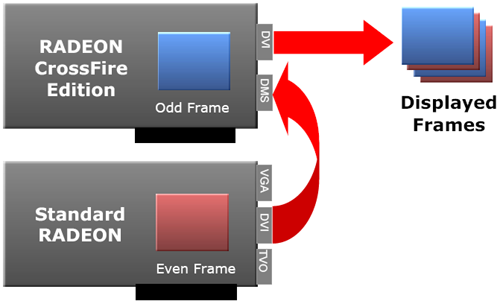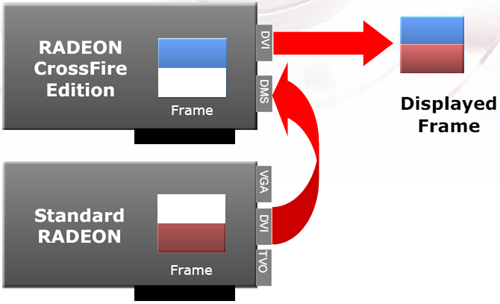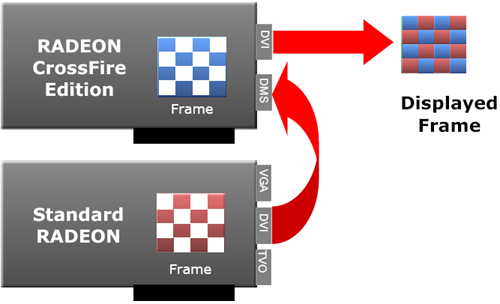ATI's Multi-GPU Solution: CrossFire
by Anand Lal Shimpi & Derek Wilson on May 30, 2005 9:00 PM EST- Posted in
- GPUs
Rendering Modes
The task of getting two separate video cards to handle drawing frames efficiently for a single application transparent to the programmer and end user is quite an undertaking. When life was fillrate limited, 3dfx solved the problem by having each card render odd and even scanlines, which were then combined in analog. This solution is no longer viable, but ATI and NVIDIA have both come up with ways to accomplish the goal.The absolute most desirable mode of operation that both companies have come up with is alternate frame rendering (AFR). As the name implies, each card renders an entire, separate frame. The major advantage to allowing each card to render an entire frame is that each card is able to handle the geometry processing required as well as the pixel processing.

Alternate frame rendering can't always be used for various reasons (such as the case when one frame depends on the previous result). When alternate frame rendering cannot be used, splitting the current frame vertically is an alternative that both ATI and NVIDIA have implemented. When the work for a single frame is split between two cards, the geometry pipeline can't be divided as easily as the pixel pipeline. As a scene is being rendered, it is not easy to assign objects to different cards as all objects in a scene can affect any of the pixels.

After geometry is sorted, a guess can be made as to how much pixel power will be required for different areas of the screen, and NVIDIA takes advantage of this to distribute the workload more evenly across the two cards. If the top half of the screen isn't as difficult to render, more than half the screen is given to the card assigned to the top. This method definitely helps to keep cards rendering split frames evenly loaded. ATI is capable of splitting the rendering work 60/40 or 70/30 under their scissor mode, but the split is determined per application.

Evenly dividing work is a very important task, and ATI has taken it a step further with CrossFire. They are introducing a rendering mode, which they call Supertiling. This mode splits the entire screen up into 32x32 pixel tiles and hands out a checkerboard pattern to each graphics card for pixel processing. Doing this effectively takes the guess work out of load balancing pixel processing between two cards. The workload averages itself out when the cards share the pixels in areas so near each other.
The caveat of Supertiling is compatibility. It has come to our attention that the "small number of applications" for which Supertiling does not work includes all OpenGL based titles. This means that OpenGL has either AFR or split frame rendering options available. AFR is the most desirable mode, but it would be nice to have a middle ground with more effective load balancing.
In addition to these multi card render modes, ATI has gone a step further to include enhanced AA modes. This is made possible by taking advantage of programmable sample points and their hardware compositing engine.










57 Comments
View All Comments
yacoub - Tuesday, May 31, 2005 - link
Is it just me or do several things about this scream "bottleneck" and "latency"? The 2PCI-E x8 slots instead of x16 slots. The extra Compositing Engine chip. The ability to pair different cards such that it will drop clock speeds and/or pipelines to sync them up. The lack of direct chip-to-chip interconnect.I'm curious to know just how much performance gain is realized if you pair, say, an X800XL and an X850-something, over just the X850-something. And also how much bottleneck and latency there is in this implementation over the NVidia offering of SLI.
The only upside I can see is cost/upgrade since a user can own an X800-based card (assuming they have a Crossfire compatible motherboard) and go out and buy an X850-based card later and use BOTH cards together (assuming they are both Crossfire-capable cards). Then again with those assumptions I'm not sure it's truly any more cost-effective. =\
LoneWolf15 - Tuesday, May 31, 2005 - link
As usual, the fanboys of both sides come to the show to spout their comments.For everyone saying "Man, you have to buy a Crossfire that matches your card, and throw it away when you upgrade"...umm, don't you have to buy two of the exact same matching card for running nVidia SLI, and if you wish to upgrade, you have to sell both? Doesn't sound that different to me. One thing I think a lot of current ATI owners will be happy about is that they won't have to get rid of a card they already own and buy two of a new one; they can just buy a single Crossfire card (and of course a mainboard).
On the other hand, to those thinking ATI has now "0wned" nVidia, it is WAY too early to tell. The solution looks promising, but if you have to sacrifice mainboard performance (i.e., SATA hard disks, memory bandwidth, etc.) it may be a hard sell. Benchmarks in Doom 3 are also not the end-all be-all. We'll have to wait for a more comprehensive performance review, including DirectX benches, and performance/quality with older games using this new AA method, as well as game compatibility reports. We'll also need to know what TRUE pricing is (we've seen claimed pricing vary quite a bit from what it has turned out to be at product release in the past two years).
Do I hope it will beat nVidia's solution? You bet. I like ATI, but even more I like competition that drives the industry. Do we proclaim ATI the winner/loser on this one? Heck no, it isn't even a purchaseable product yet.
ElMoIsEviL - Tuesday, May 31, 2005 - link
23 - They ran Doom3.It's not an ATi game at all as we all know. And it still does REALLY well. And it's not in release stages yet.
;)
ElMoIsEviL - Tuesday, May 31, 2005 - link
hehehehe.. it's better then SLi... heheheheFigures, all the NV on here prolly aren't too happy today.
I can't wait to test out the new AA modes.. :)
vertigo1 - Tuesday, May 31, 2005 - link
This is insane, who on earth will buy this?!JarredWalton - Tuesday, May 31, 2005 - link
30 - Yes. The PCIe bus likely provides slower performance, as it is used for lots of other things (like communication between the CPU, RAM, and GPUs). I believe NVIDIA SLI works without the dongle but at slower speeds - at least, I heard that somewhere, but I haven't ever had an SLI board so I can't say for sure. Anyway, since DVI is a digital signle, using DVI in/out seems about as good as the SLI bridge - at least in theory. Now we just need to wait and see how theories pan out. :)Jalf - Tuesday, May 31, 2005 - link
I was under the impression they were going to use the PCI-E bus for transferring data between the cards. Is the external dongle going to handle that instead?Murst - Tuesday, May 31, 2005 - link
I really don't see how the xfire is better than sli based on hardware compatibility. Sure, you don't need the exact same cards, but you will likely buy only one x850 type card per x850 xfire. It would be extremely unlikely that someone upgrades from x850 xt pro -> x850 xt pe.Basically, in the end, you will buy a specific xfire tailored to your gfx card, and throw it away with the next generation of cards.
gxsaurav - Tuesday, May 31, 2005 - link
Great this just means more heat, man, even a single 6800 nU playes everygame fine, while running coolViRGE - Tuesday, May 31, 2005 - link
#21, yes it is. This is what hurts ATI the most, Nvidia already had 4 release cycles of experience with motherboards(2 of those being highly popular, highly recommended boards) before attempting SLI. ATI has a previous launch for a board almost universally ignored. I would not use an ATI board at this time, so I would also not consider CrossFire. ATI needs to get CrossFire working on Nvidia's boards to have a fighting chance this round.